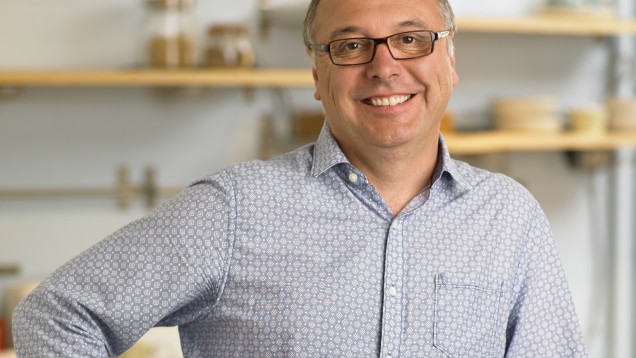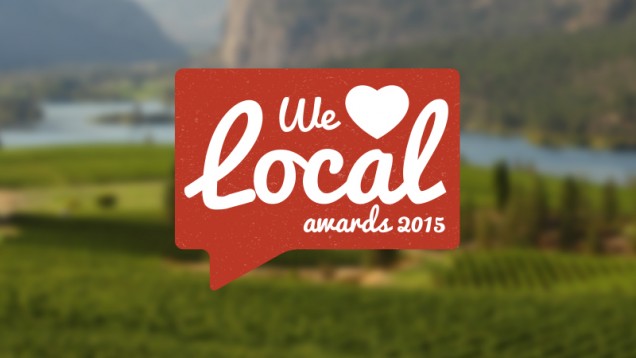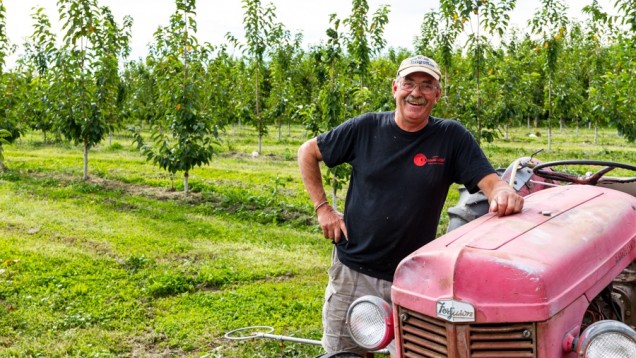
The Great Rotisserie Chicken Cookbook: we interview Chef Eric Akis
June 9, 2015
Love local, win big: It’s the third annual We ♥ Local awards!
August 17, 2015
It’s a good life: we talk to farmer Greg Norton about the Environmental Farm Plan
Greg Norton is a third generation cherry farmer in BC and the Chair of the Industry Advisory Committee for the Environmental Farm Plan program. The Environmental Farm Plan program supports farmers in assessing how to make their farming practices more sustainable – and then putting their plan into practice. “I have a bent for agriculture and the environment – it’s been my life,” he explains. “So getting involved in the Environmental Farm Plan made a lot of sense: it’s a perfect fit.” We were lucky enough to catch up with him on the very first day of the cherry harvest at Okanagan Harvest Farm, where he talked to us about the Environmental Farm Plan from a BC farmer’s perspective.
We Heart Local: Can you start by telling us a little bit about your third-generation family-run farm?
Greg Norton: (Right now) we’re running 23 acres of primarily cherries. I’m third generation – my grandfather bought the main farm in 1926. We operate three different properties and I’ve been farming my whole life, farming full time for 27 years.
WHL: What’s kept you on the farm?
GN: The independence. Living and dying by your own decisions instead of listening to someone telling you what to do! It’s a pretty uncertain lifestyle, so you learn how to budget, and you learn how to only spend money when you’ve got it. You wake up in the morning, and you work with nature: it’s a pretty good life.
WHL: Tell us about the Environmental Farm Plan. Can you start by explaining what “environmental stewardship” means?
GN: In my view, farmers are the practicing environmentalists in the province of BC. In order to be successful, we have to understand and work with the environment. So I don’t see a big separation between environmental stewardship and good farming, you know? If you don’t understand your environment – if you don’t get a feel for the grass, and the moisture in the soil – you end up with a practice that’s harming the environment, which means you’re harming your own livelihood. So there’s a very direct relationship between being on the land, farming it, and the environment – to me, they’re one and the same. The Environmental Farm Plan workbook helps define your relationship to the environment as a producer more specifically. As you go through the workbook and you check off all the different sections, it sharpens your awareness as a producer. It also highlights traditional practices where a small adjustment can help – so for example, conserving water obviously benefits the producer: being more efficient with water use, you get better crops and bigger crops, but it also really benefits the environment. It’s win-win.
WHL: Can you tell us about the impacts EFP assessments have on BC farms? What sort of investments are made, and how do BC farms become more environmentally sustainable / aware of their environmental footprint?
GN: In my case, my poor old dad really did shake his head a lot when I was out there doing soil tests. But as a result of that first year of soil analysis I’ve never put one pound of nitrogen on the land – I didn’t have to! My dad was pretty surprised that the trees didn’t die when I wasn’t using nitrogen – in fact they produced better – and so I really did convince him. I also changed all of my irrigation systems. This was a big transition for him but he got it in the end.
The Environmental Farm Plan is a voluntary program, you write your plan and if you decide to go forward with it and you need to purchase that new piece of equipment, then the program can often help out. There’s significant out-of-pocket cost for a producer who decides to go forward with it, but there are other benefits for that producer. It’s doing the right thing. Farming is complicated, and sometimes it just takes filling out that workbook and saying “I’m 85% there. And I want to be 100% there.” It’s human nature to want to improve, and I think that (insight) is the real value of the Environmental Farm Plan.
WHL: How does the Environmental Farm Plan affect consumers?
GN: We’ve got a lot of work to do in terms of making the consumer more aware of the Environmental Farm Plan. Consumers have become much more aware of what they’re eating, and the relationship between agriculture and the environment, but I’m not sure they’re aware that over the past 10 years producers have been doing environmental farm planning and really making some good steps forward as far as reducing agriculture’s impact on the environment.
With greater numbers of consumers factoring the environment into their purchase decisions, farmers are starting to market their EFP’s now. For example, EFP signs can now be seen at hanging at vendor booths at farmers’ markets, and forward thinking chefs like Chris Whittaker at Forage restaurant are starting to actively source from EFP farms.
To find out more about the Environmental Farm Plan, visit here – and to hear more stories from BC’s farmers, check out the stories on Our Farmers page or follow us on Facebook.